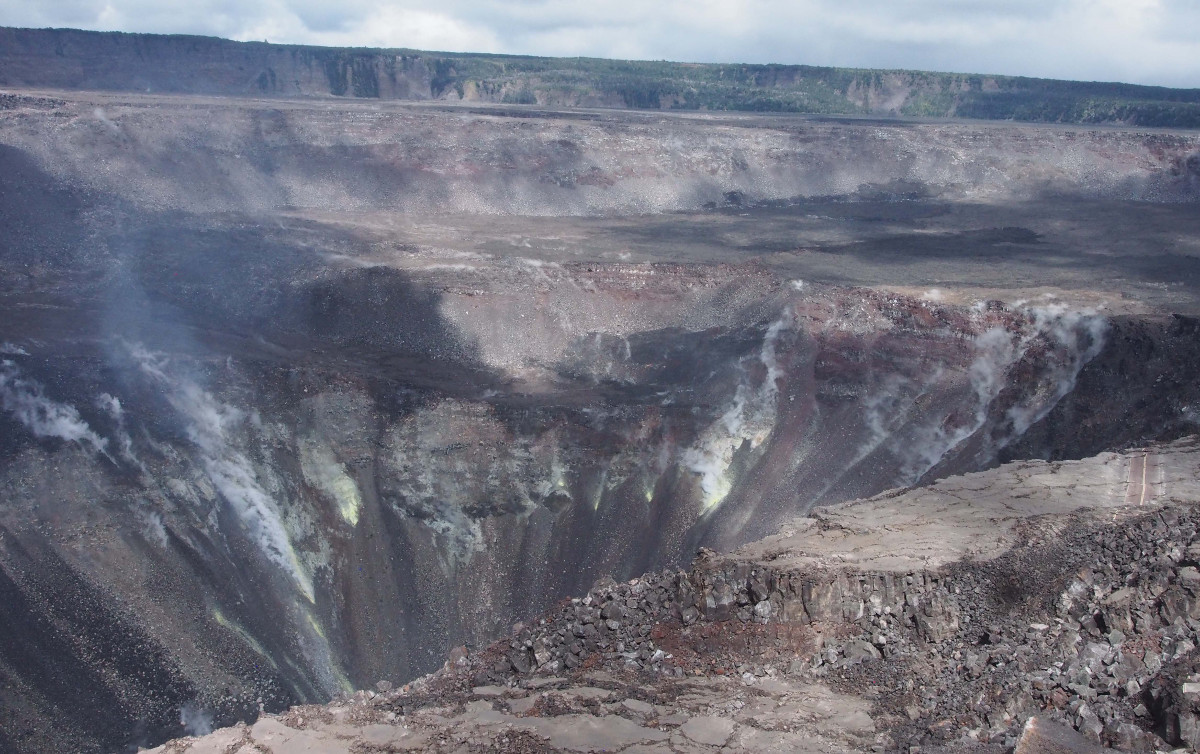(BIVN) – Kīlauea is not erupting, but according to scientists at the U.S. Geological Survey Hawaiian Volcano Observatory, the current inactivity lends to an intellectually exciting time for geologists.
In this week’s Volcano Watch article, written by USGS Hawaiian Volcano Observatory scientists and affiliates, the excitement is explained in detail:
Now is an exciting time at Kīlauea
This is, without a doubt, the most intellectually exciting time to be a volcanologist at the USGS Hawaiian Volcano Observatory. The current inactivity at Kīlauea has so many possible outcomes that it is a real challenge to figure out what might happen next. And intellectual challenges are stimulating and exciting.
What will happen? New summit lava lake, resumption of eruption at Puʻu ʻŌʻō, lava flows in Puna, further summit collapses, explosive eruptions from the summit, eventual collapse of the entire summit, renewal of caldera filling with lava eventually overtopping the caldera rim, decreased magma supply so that the quiet lingers for years, increased magma supply so that the quiet ends in months, resumption of Mauna Loa activity…or something else?
Any of those possibilities could happen, and we are challenged by having to weigh all of them and more. And this is hard. No matter how much we may know, the truism remains: there are no facts about the future.
One thing is clear. It is not the duration of the present quiet period that is so intriguing. There have been many other longer periods in the past 150 years with no lava visible, some lasting years. But those were times when monitoring was sparse and crude, ideas were rudimentary, and the scientific involvement was limited to a small number of generalists.
Now the monitoring capability is enormous and sophisticated, ideas about what might happen are varied and thoughtful, and the intellectual workforce spans the globe as local scientists receive input in near-real time from specialized, experienced, and insightful colleagues around the world. Much more can be made out of the current quiet than could be done before, and therein lies the challenge.
With all this firepower, can we get the outcome right, and if we can’t—perhaps realistically the most likely outcome—then can we be within striking distance and learn enough to do better the next time? This is exciting stuff!
Research scientists need intellectual challenges. We are buffeted by daily personal and societal triumphs and failures, as are most people, while at the same time trying to find order in the chaos of the natural world that operates on a 24/7 schedule.
Creativity is the hallmark of research scientists, and it demands, almost paradoxically, an approach that is both focused on the problem at hand and broad enough to consider as many eventualities and ramifications as we can imagine.
Creativity is as important to research scientists as it is to artists. Both pursuits are limited by personal ability and the availability of tools of the trade. All artists and research scientists share the same need to come up with something new, to be different in ways that stimulate others to follow new directions or novel ways of thinking. The process of creating is exciting, no matter what the field, and it can lead to enjoyment and enlightenment for society when things fall into place.
There are differences, however. Creativity for a research scientist is bounded by physical and chemical realities, whereas the artist can pursue supernatural approaches. And, a research scientist strives to adhere to observations, facts, and logical inferences, whereas an artist is free to ignore such constraints.
The writer of this essay is nearing the end of a long eventful research career. It is no exaggeration to say that the current quiet at Kīlauea is the most exciting and challenging research time in 50-plus years of investigating the earth. Younger colleagues might think that’s hyperbole, but with time they will realize the marvelous intellectual experience that the inactivity of Kīlauea provided them. Perhaps they will be lucky enough to experience something even more exciting before they hang up their boots. This writer hopes so but is doubtful.
Opportunities such as 2018 Kīlauea are unusual. When they happen, seize the day!


by Big Island Video News9:20 pm
on at
STORY SUMMARY
HAWAII VOLCANOES NATIONAL PARK - In this week's article, the USGS Hawaiian Volcano Observatory asks "what is next for Kīlauea Volcano?"